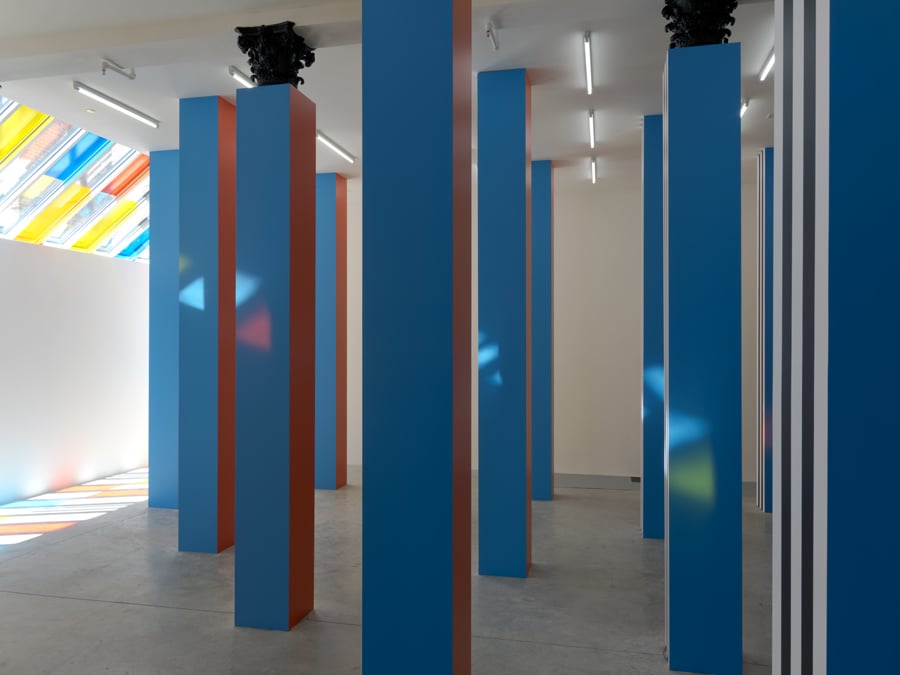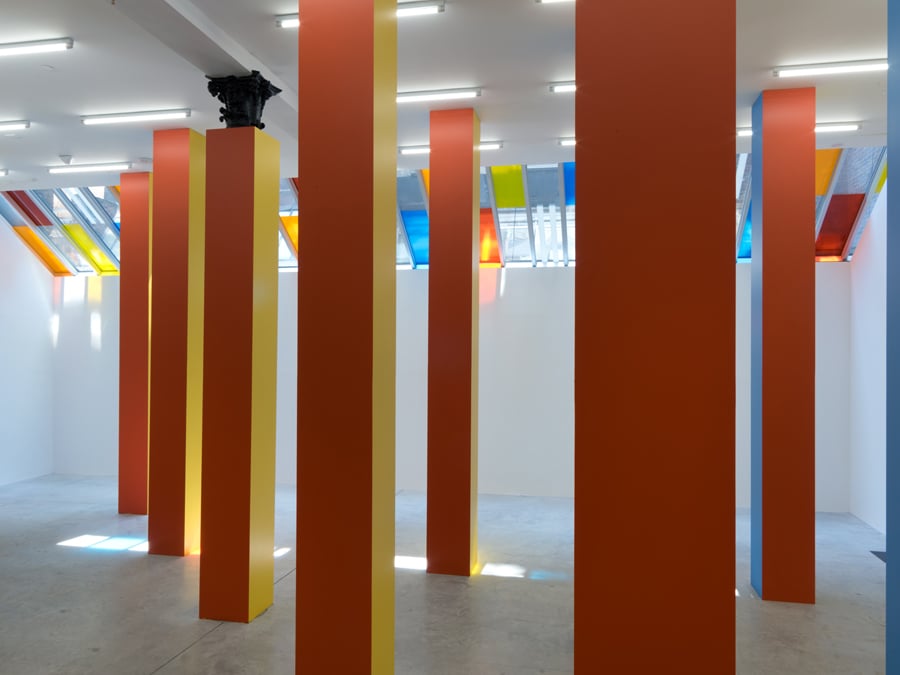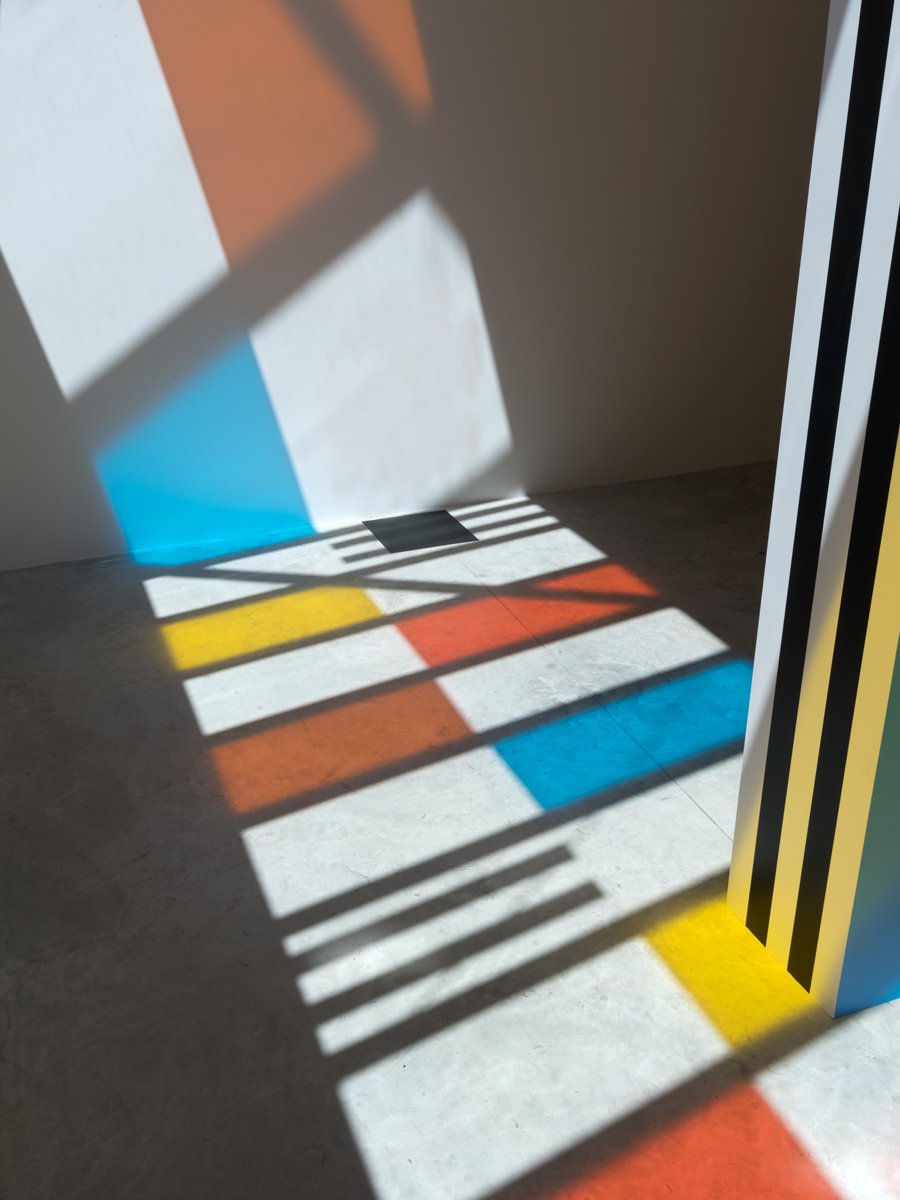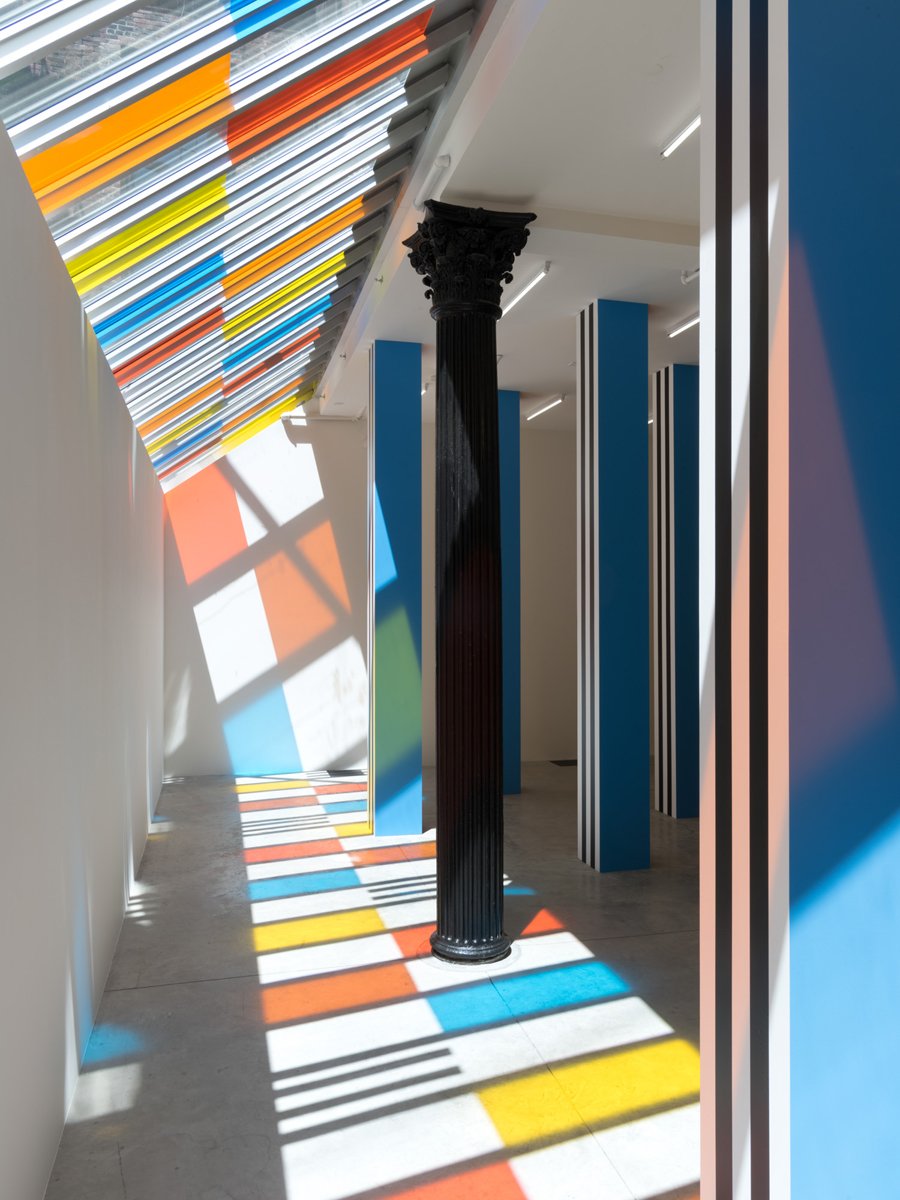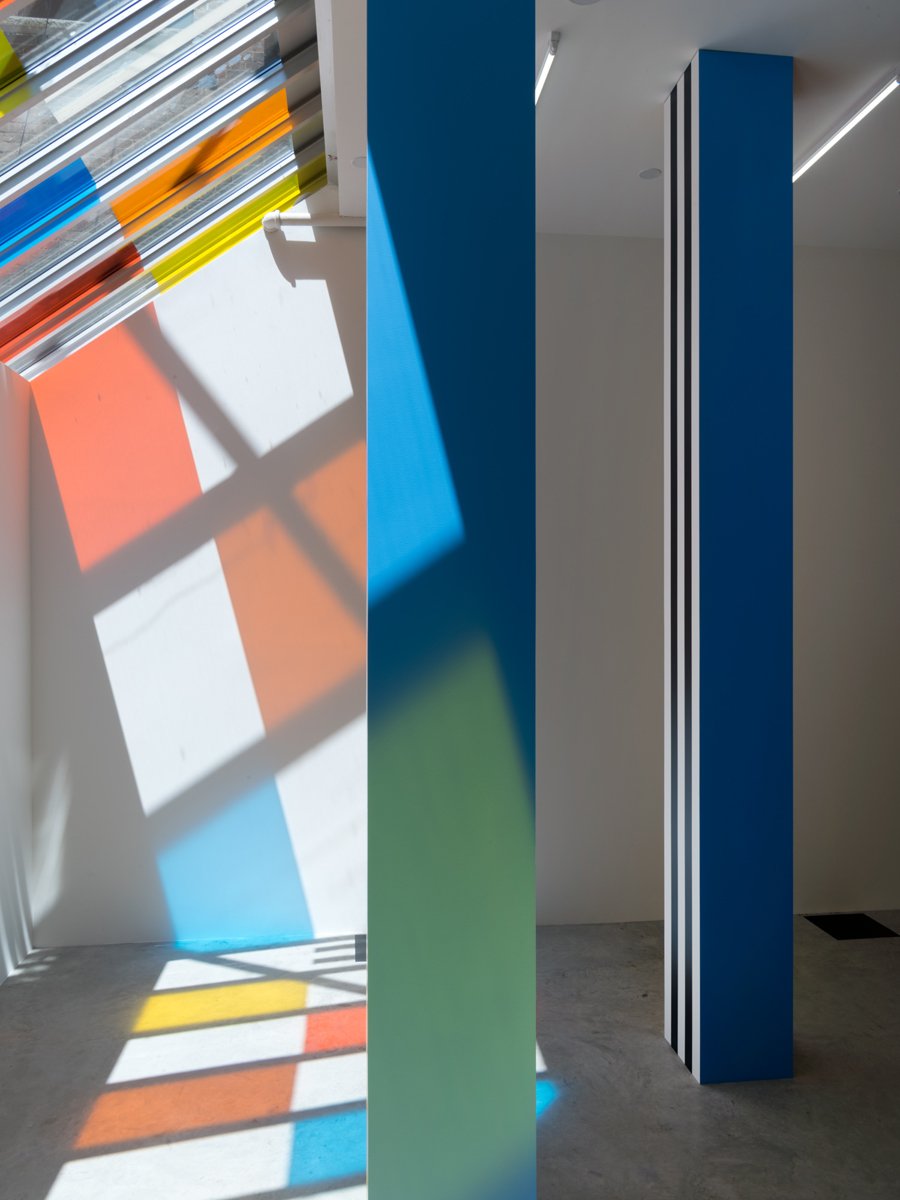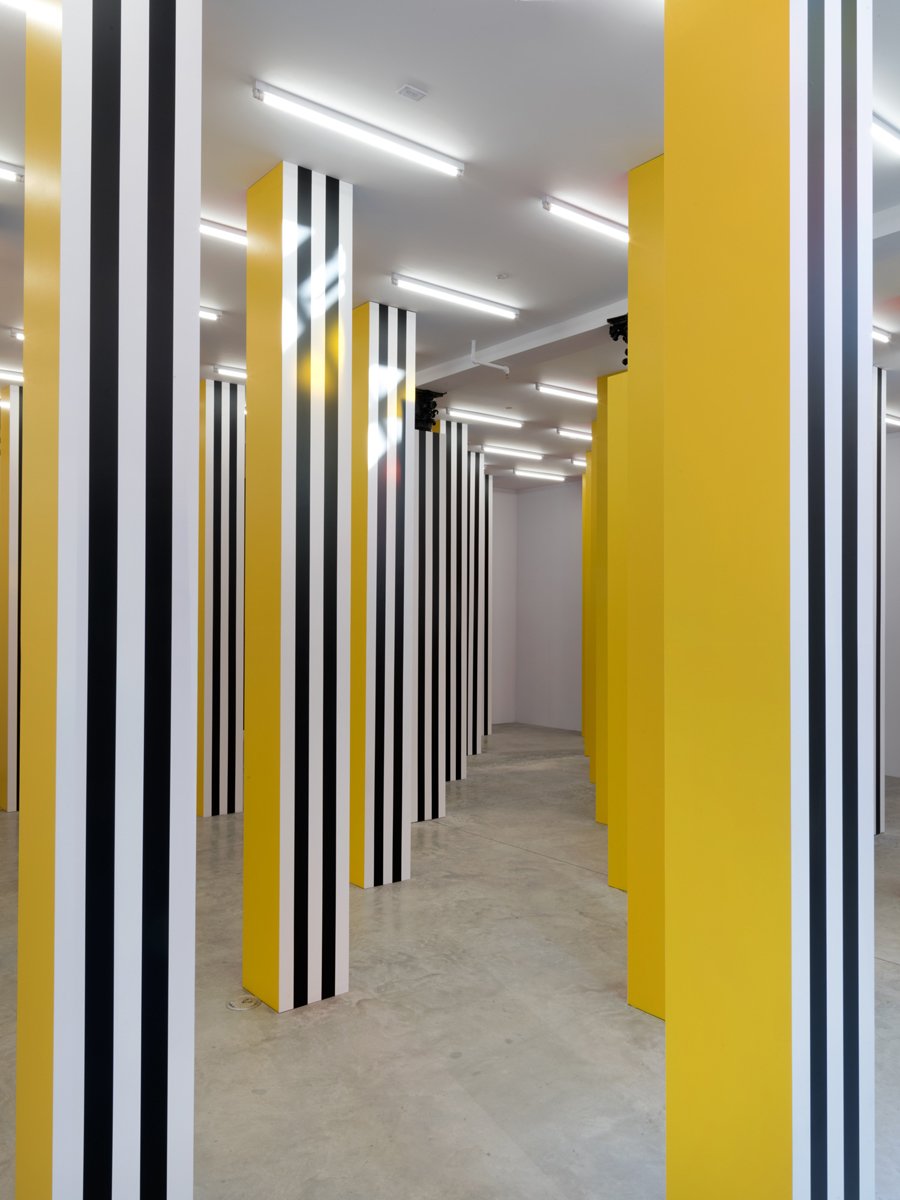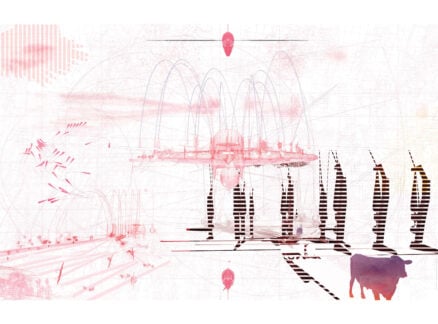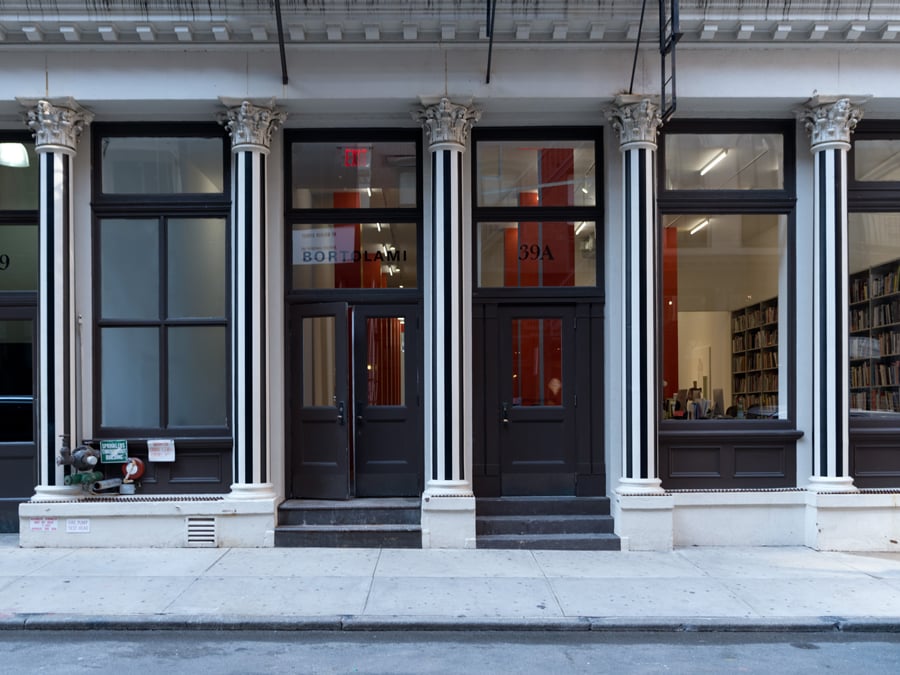
June 20, 2017
Whatever You Do, Don’t Call Daniel Buren’s Artworks “Installations”
In the first of his series of interviews with architects and artists, Vladimir Belogolovsky interviews renowned conceptual artist Daniel Buren about the fuzzy line between his art and the architecture that holds it.
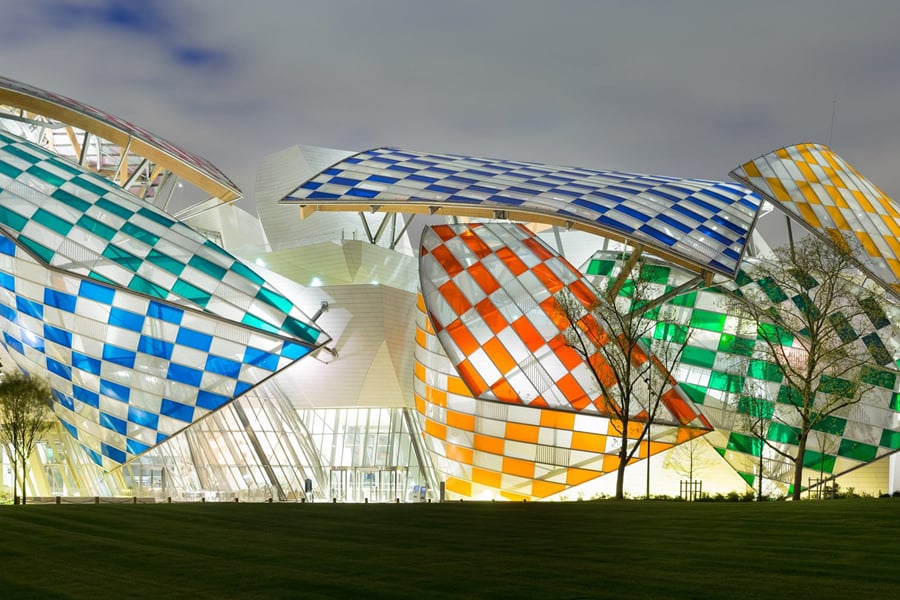
A Parisian artist, Daniel Buren—often referred to as “the stripe guy,”— is one of the most prominent conceptual artists practicing today. His work has been displayed in such prestigious art spaces as the Grand Palais and Centre Georges Pompidou in Paris and the Guggenheim Museum in New York. In 1986, he represented France at the Venice Biennale and was awarded the Golden Lion for the best national pavilion. One of his most iconic works in situ, as the artist describes his creations, is installed permanently at the Cour d’honneur at the Palais Royal in Paris. Still, most architects know him for last year’s bold, temporary transformation of the Louis Vuitton Foundation in Paris, designed by Frank Gehry. Upon learning of the artist’s new exhibition, To Align: works in situ 2017, on view at the Bortolami Gallery in Manhattan until June 24th, I couldn’t miss the chance to talk to Buren in person about his work, intentions, and visual signature: those stripes. The following is a condensed version of our two-hour conversation, which took place right before the show’s opening on May 12th.
Vladimir Belogolovsky: How would you describe yourself – an artist, minimalist artist, conceptual artist, spatial artist, contextual artist…?
Daniel Buren: From the very beginning, I was always embarrassed by the term, “an artist.” The word sculpture would be certainly the closest to describe the aspects of the kind of work I do, which is three-dimensional. Certainly, I am not a painter.
VB: You are a sculptor.
DB: I would never call myself a sculptor. You asked me a question and I answered it. I said – my work is closer to sculpture than anything else is, but I never call it a sculpture… I am certainly closer to an artist than a butcher is. But to define myself as an artist, in a way, is not clear and can be very pretentious. The title of an artist is very high and only history will tell who deserves that. Anyone can call himself an artist; a shoemaker may also be an artist… The term is blurred. Let’s say I work in the realm of visual arts.
VB: To Align: Works in Situ 2017 is your fifth show here at Bortolami and the first at the gallery’s new location in Tribeca. Could you talk about your main idea in this installation?
DB: First of all this is not an installation, and I am against the use of the word installation. I call it “works in situ,” meaning you cannot take it out of where it is. They can be temporary or permanent, depending on the commission, but most importantly, they are intrinsic to the space. Installations are things you see in the vitrines of department stores. Installations are objects that you can put anywhere. I am not interested in installations.
Anyway, I always work with a particular situation and place because, as a visual artist, before you can do anything, you are confronted with architecture. When I realized that, I quit being a painter. Either consciously or subconsciously, first, we are dealing with architecture and people. Before I do anything, I always consider these two key elements. My work is critical; it always starts with either being for or against architecture of the place. It is architecture of the place that feeds me with ideas for my work. It is architecture that makes me nervous, confused, or excited. My proposal is never definitive; it is just one of many possibilities. So when someone says—“this is what should be done here”—I always laugh because I know that any proposal is just one solution out of numerous others that could have been just as good.
VB: So what was your idea for this show?
DB: I don’t think there was an idea here. [Laughs.] It is a way to use the space and again, it is just one of many ways. When I am invited to do a show I come for, let’s say, ten days and I work right in the space to transform it. That’s why I don’t have and don’t need my own studio. I come up with my ideas when I work directly in the space.
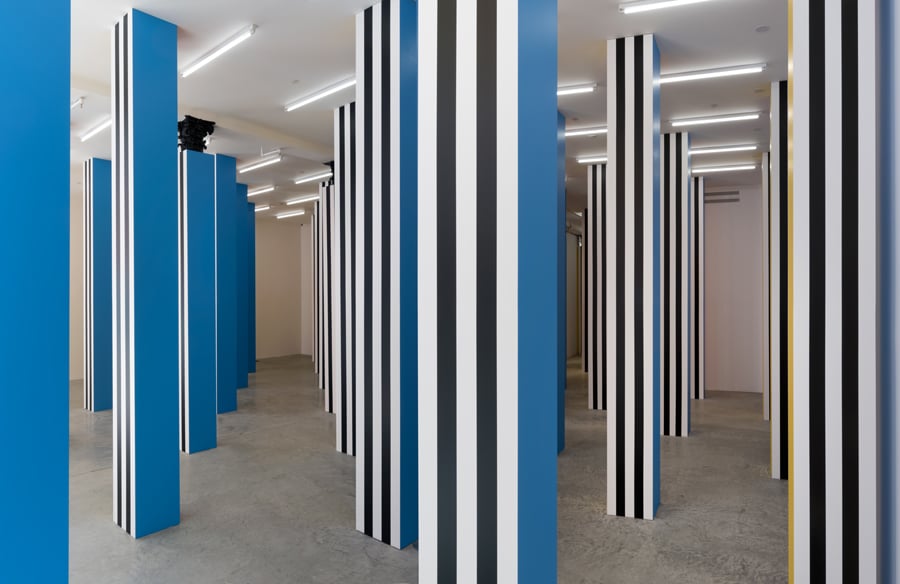
VB: It was in September 1965 that you were visiting a Paris market to buy canvas for your paintings when you noticed a striped awning fabric with vertical bands, each 8.7 cm or 3.5 inches wide, which were alternately white and colored. You then started using similar fabric to create your own art. Gradually you stripped painting down to its core, or “degree zero,” as you called it, and started to use stripes as a “visual tool,” placing them in various contexts both inside galleries and in relation to architecture. Could you talk about this experience and what was your main goal in creating these works?
DB: I was working on [reducing paintings] to their absolute core, to what they were, nothing more than dumb stripes. I did those paintings in a traditional way, but I tried to exclude any signs of emotions. Suddenly I saw these stripes on fabric and I said – this is exactly what I want to do. So I started using fabric with stripes instead of painting them on canvases. At the time, I could not afford to have my own studio, so that forced me to experiment with different materials directly in the streets of Paris. The city became my canvas, and I started using paper that I posted on billboards and buildings as posters. That happened in 1967 and, as you can imagine, I worked without any permission. I was absolutely free! Later I started getting invitations to present my works in galleries. Anyway, the most important shift that took place was the fact that I started working directly with the wall. The canvas disappeared.
VB: You were moving away from the canvas to using the wall directly—why?
DB: I was moving away from conventions, from the gallery, from the whole system, and from the painting itself… Why? Just because! [Laughs.]
But speaking about me personally, I was curious about trying to work outside of the system and particularly without the control of the space inside the gallery. It was a very banal but very powerful idea, and the only way to know how to work outside of the system was to go outside of the gallery—without knowing whether anyone would invite me back. I did not think about that at all. But as soon as I was invited to the gallery I showed my work the way it was shown on the street. I am interested in these dialogues between inside and outside of the gallery or museum, and between inside and outside of conventions.
VB: You said you use these stripes because they don’t have any meaning – just rhythm. So why do you use them? What is the intention of your work?
DB: The original intention was to be absolutely neutral. Over time people started identifying the stripes with my name, so for those who know me the stripes are no longer neutral. It has become my signature. In the beginning, I thought it was something very negative, but after a while, I realized that it was very positive. In the art world if you show something once and then again, that will be seen as a connection, and if you show something completely different, no one will recognize you anymore. So I think signature is important as a visual link from one work to the next.
VB: Speaking of your use of stripes as a visual tool or signature you said, “It’s not only something you can recognize; it’s also something I can use to change an environment.” Could you elaborate? Is it important for you to have a signature style?
DB: I acknowledge the stripes as my signature but not because it is important. It is just there. At the same time, now I would not dare to change it, and not because people would not recognize me or say that my work is boring. I don’t care. My work is meant to be boring…
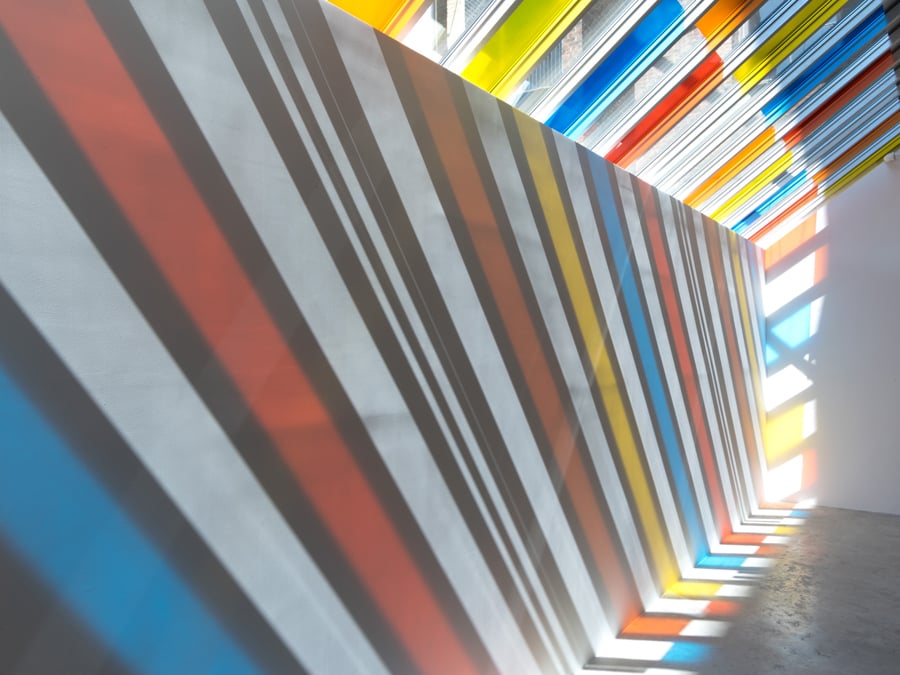
VB: Your work is meant to be boring…
DB: My work is not meant to be boring, but let’s face it, stripes are boring to begin with. The reason I use the stripes is because it is absolutely meaningless.
But more than that, the stripes helped me to reveal the wall and the space. As soon as I glued my stripes to the wall or billboard, the attention was shifted from the stripes to the wall itself, as well as everything around it – the street, the whole city became part of my work! That’s the difference between a painting on the wall and my work applied directly to the wall.
VB: What is the difference between a traditional painting and your pattern on a wall?
DB: Any painting is done to blind you! When you try to see the painting, you cannot see the wall. My interest was in making it possible to see the wall or billboard, or curtain, or whatever material I was using. And not only did it become possible to see the wall itself, but also around it and behind; the wall or the background became part of the painting, whereas traditional paintings always were separated from the wall by their frames. Even when you look at a window, there is no separation from the wall unless you look out of the window. Paintings are different: for a painting to exist, it must show itself. It can’t be neutral. My stripes are completely banal and neutral, so they focus attention to the wall and space. Over the years, I started also using mirrors, color filters over glass, colored surfaces, and so on, but the stripes are always there.
VB: You arrange colors in alphabetical order to show that the effect of color does not depend on the artist’s preference. Does this mean that you are intentionally trying to be more theoretical than experiential?
DB: I think both. Every time I use more than two colors, I am confronted with reasoning – why this color next to that color? So I either use colors by chance or ask different people who work with me to make the choice. That way I keep myself distant from any decisions about colors.
VB: Why is that?
DB: To remove my personal taste from my art. Even if I tried to suppress it, it is impossible not to show some preference toward certain colors, so I simply remove that possibility. My art is different from my taste. My taste is of no interest to anyone else.
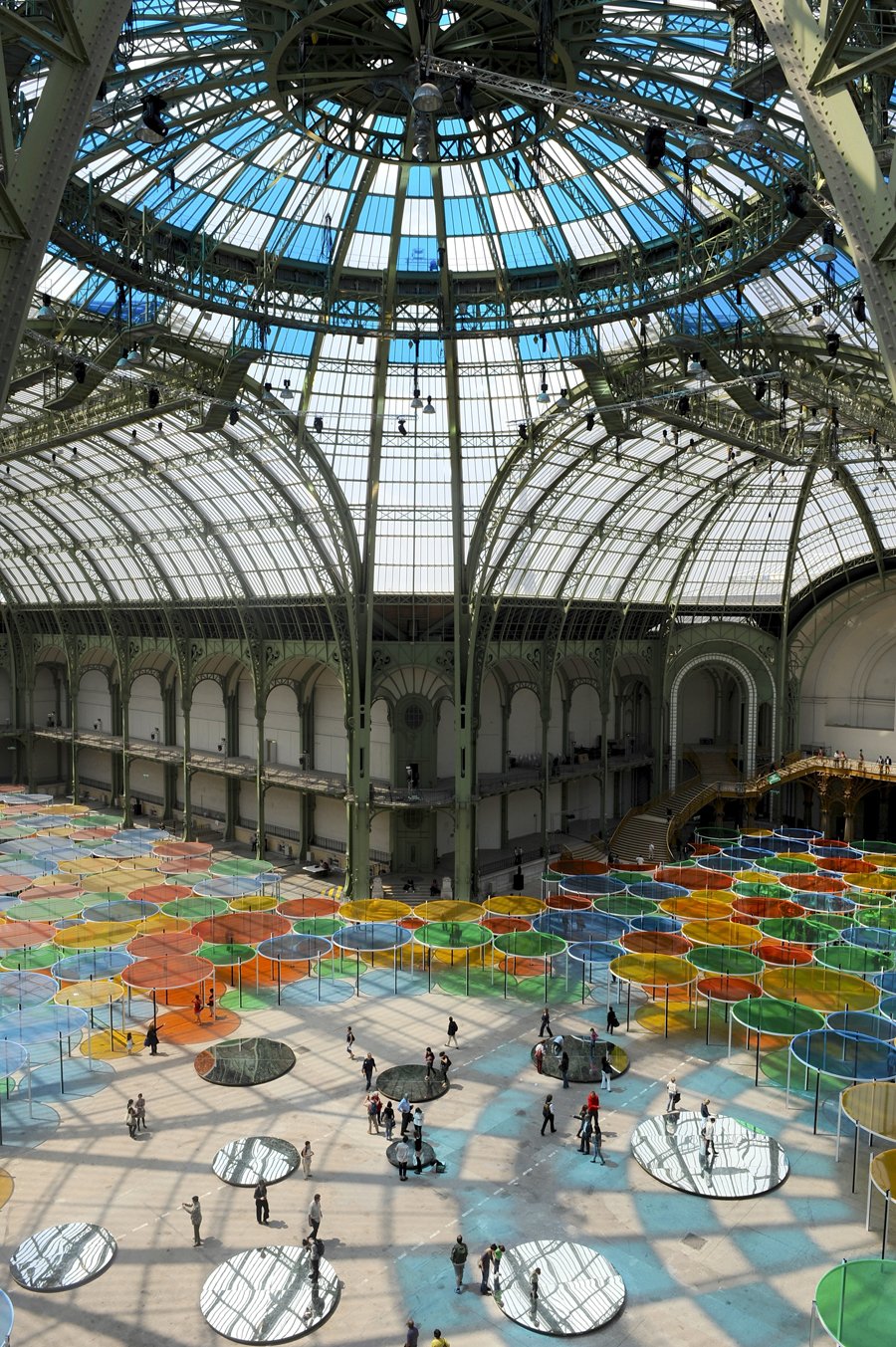
VB: In 1970, you said, “The bands are 8.7 cm wide, alternating between white and colored, and are placed over internal and external surfaces: walls, fences, display windows, etc. . . . I record that this is my work for the last four years, without any evolution or way out.” Could you touch on the evolution in your work?
DB: Today my work reflects the space it is in. You go into the gallery here and you see my work. Of course, the architecture you see here does not belong to me and it has nothing to do with me. So when we talk about my work, it is quite confusing because it is hard to separate it from the space it is in. In the first few years, my visual expression means were very limited – I always repeated using the same stripes of the same width and at the same distance. The only difference was the size of my canvases and the colors of my stripes. There was no escape. After 1970, I was much more open, and each time there was a show something else came into my artistic vocabulary. But the stripes remained. If you see the stripes they are always vertical, 8.7 cm wide, and they always alternate between white and another color. So there was absolutely no evolution in the beginning, but since 1970 the work has evolved.
VB: You said, “My work is never autonomous.” Not autonomous in what way?
DB: In every way! [Laughs.]
VB: You mean it cannot be by itself.
DB: Impossible!
VB: Your work is a part of architecture or space.
DB: Precisely. It is a rare idea, don’t you think? Maybe I am the only artist who insists on this condition because all the art that was produced from the beginning of time is declared to be autonomous. And for good reason, because if the artist does not believe in his work’s autonomy it is not that interesting. But I take the liberty and risk to say – my work is not autonomous. My work is a part of everything around it and it has the power to transform everything around it.
VB: You also said, “All artists are, first of all, decorative artists.” Now I understand your criticism because your work is in opposition to being decorative.
DB: It is not even autonomous… [Laughs.]
VB: Last year you transformed Frank Gehry’s new building for Louis Vuitton Foundation in Paris. Could you talk about your experience of working with architects?
DB: In Paris, it was not exactly a collaboration because I worked directly with the building. I talked to Gehry, of course, because we are good friends and he assured me that I can do what I feel is right. We’ve been friends since I first met him in Los Angeles in 1972. We never worked together, but I did work with other architects. For example, I did a permanent artwork with Jean Nouvel at his social housing project in Nimes, France [1988]. I also collaborated with Renzo Piano, but nothing was realized. And I worked with more anonymous architects in France. But, you know, many architects are very critical of my work and they would never want to collaborate with me.
VB: Your work is too strong; they fear it would compete with their architecture.
DB: Absolutely. Even when I had my shows in certain museums, architects would protest—we are talking about architects that are not even that good. At least my work is temporary, but their banal buildings will last for a long time. [Laughs.] It is interesting that we assume that architecture is art, the mother of all arts, but even such giants as Le Corbusier or Mies never worked with artists.
VB: Niemeyer did, but you are right it was very unusual for modernists.

DB: Le Corbusier preferred to do everything by himself – paintings, murals, stained glass windows, sculptures, ceramics… He was a friend of Picasso and he never asked him to do anything. If you think about it, it is almost scandalous and ridiculous. He was a great architect, but as a muralist, he was just fine, even banal in how he was following Picasso. He would have been well served by the master. Instead, he chose to imitate the master. However, the new generation of architects, let’s say from the ‘70s, developed a completely new attitude toward collaboration with artists, which is now much more common.
Speaking of my other encounters with great artists and architects, I met Picasso; I practically spent a whole week with him in Provence when I was just 17. I also met Luis Barragan in Mexico and I have a great affinity for his architecture. I also had a close friendship with Sol LeWitt; in fact, our work has certain parallels, as far as the use of the space, instructions, and treatment of the wall.
VB: If you were to describe your work with a series of single words, what would they be?
DB: Invention. Obstinacy.
VB: Looking back to so many of your…
DB: Be careful not to call them installations. [Laughs.]
VB: Well, exhibitions and works in situ, would you say there is an evolution in your work? What did you learn from your life-long project?
DB: I may not be in the position to see it but I think there is evolution, which I see as a zigzag. The evolution is not linear and it may not be progressing. Sometimes the work gets better, sometimes worse. And the kind of work I do today I would not even think of doing in the past. But what I can say is that I absolutely have to work. The work itself is the fuel that drives my project forward. The new work comes out of the work I have done before. All ideas come from working. Work produces work. Philosophy, concepts, and ideas are important but the work itself is much more important. The making of something physically opens doors you never thought existed. When you know that, you don’t want to stop. That’s the lesson. You have to be ready for a good idea.
Vladimir Belogolovsky is the founder of the New York-based non-profit Curatorial Project. Trained as an architect at Cooper Union, he has written seven books, including Harry Seidler: The Exhibition (ORO Publishers, 2017) and Conversations with Architects in the Age of Celebrity (DOM, 2015), and curated numerous exhibitions.. His latest exhibition, Voices, will travel to Mexico City in August and Buenos Aires in October after two successful iterations in Sydney and Chicago last year.
In this, his monthly column for Metropolis, “Dialogues: Architecture Meets Art,” Belogolovsky interviews international architects, artists, and designers about such fundamental questions as: what is architecture, what is art, and what is an exhibition?
Recent Profiles
Profiles
Chris Adamick Designs for Life






